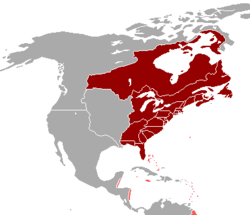
Back أمريكا البريطانية Arabic Britaniya Amerikası Azerbaijani Британска Америка Bulgarian Amèrica britànica Catalan Britská Amerika Czech British America German América británica Spanish آمریکای بریتانیا Persian Brittiläinen Amerikka Finnish Amérique britannique French
British America and the British West Indies[a] | |||||||||||||||||||||
|---|---|---|---|---|---|---|---|---|---|---|---|---|---|---|---|---|---|---|---|---|---|
| 1585–1783 | |||||||||||||||||||||
| Anthem: God Save the King | |||||||||||||||||||||
 British colonies in continental North America (red) and the island colonies of the British West Indies of the Caribbean Sea (pink), after the French and Indian War (1754–1763) and before the American Revolutionary War (1775–1783) | |||||||||||||||||||||
| Status | Colonies of England (1585–1707) Colonies of Scotland (1629–1632) Colonies of Great Britain (1707–1783) | ||||||||||||||||||||
| Religion | |||||||||||||||||||||
| Government | Constitutional monarchy with various colonial arrangements | ||||||||||||||||||||
| Monarch | |||||||||||||||||||||
• 1607–1625 (first) | James VI and I | ||||||||||||||||||||
• 1760–1783 (last) | George III | ||||||||||||||||||||
| History | |||||||||||||||||||||
| 1585 | |||||||||||||||||||||
| 1610 | |||||||||||||||||||||
• Bermuda | 1614 | ||||||||||||||||||||
| 1620 | |||||||||||||||||||||
| 1632 | |||||||||||||||||||||
| 1655 | |||||||||||||||||||||
| 1670 | |||||||||||||||||||||
| 1713 | |||||||||||||||||||||
| 1763 | |||||||||||||||||||||
| 1775–1783 | |||||||||||||||||||||
| 1783 | |||||||||||||||||||||
| Currency | Pound sterling, Spanish dollar, bills of credit, commodity money, and many local currencies | ||||||||||||||||||||
| |||||||||||||||||||||
British America, known as English America before 1707, comprised the colonial territories of the Kingdom of England (and Kingdom of Scotland) of the overseas English Empire, and the successor British Empire, in the Americas from the founding of Jamestown in the new Virginia colony in 1607 to 1783.[1] These colonies were formally known as British America and the British West Indies immediately prior to thirteen of the colonies rebelling in the American Revolutionary War (1775–1783) and forming the newly-independent United States of America.
After the conclusion of the world-wide war (having grown besides the North American colonies to involve other European nations / kingdoms of France and Spain), with the signing of the Treaty of Paris of 1783, the term British North America was used to refer to the remainder of Great Britain's British Empire possessions in the Americas with what became Canada, the British West Indies in reference to its various West Indies island territories in the Caribbean Sea, also British Honduras (now Belize) in Central America, and British Guiana (now Guyana) on the northeast coast of South America.
The term British North America was used in the English language in 1783, but it was more commonly used by people and historians after the issuing of the Report on the Affairs of British North America, published in 1839 and generally known as the "Durham Report".
Cite error: There are <ref group=lower-alpha> tags or {{efn}} templates on this page, but the references will not show without a {{reflist|group=lower-alpha}} template or {{notelist}} template (see the help page).
- ^ "Rights: Thomas Jefferson, A Summary View of the Rights of British America". press-pubs.uchicago.edu.


